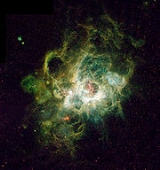
NGC 604
Encyclopedia
NGC 604 is a H II region
inside the Triangulum Galaxy
. It was discovered by William Herschel
on September 11, 1784. It is one of the largest H II regions in the Local Group
of galaxies; at the galaxy's estimated distance of 2.7 million light-years its longest diameter is roughly 1500 light-years (460 parsecs), over 40 times the size of the visible portion of the Orion Nebula
. It is over 6300 times more luminous
than the Orion Nebula, and if it were at the same distance it would outshine Venus
. Like all emission nebula
e, its gas is ionized
by a cluster of massive star
s at its center.
H II region
An H II region is a large, low-density cloud of partially ionized gas in which star formation has recently taken place. The short-lived, blue stars forged in these regions emit copious amounts of ultraviolet light, ionizing the surrounding gas...
inside the Triangulum Galaxy
Triangulum Galaxy
The Triangulum Galaxy is a spiral galaxy approximately 3 million light years from Earth in the constellation Triangulum. It is catalogued as Messier 33 or NGC 598, and is sometimes informally referred to as the Pinwheel Galaxy, a nickname it shares with Messier 101...
. It was discovered by William Herschel
William Herschel
Sir Frederick William Herschel, KH, FRS, German: Friedrich Wilhelm Herschel was a German-born British astronomer, technical expert, and composer. Born in Hanover, Wilhelm first followed his father into the Military Band of Hanover, but emigrated to Britain at age 19...
on September 11, 1784. It is one of the largest H II regions in the Local Group
Local Group
The Local Group is the group of galaxies that includes Earth's galaxy, the Milky Way. The group comprises more than 30 galaxies , with its gravitational center located somewhere between the Milky Way and the Andromeda Galaxy...
of galaxies; at the galaxy's estimated distance of 2.7 million light-years its longest diameter is roughly 1500 light-years (460 parsecs), over 40 times the size of the visible portion of the Orion Nebula
Orion Nebula
The Orion Nebula is a diffuse nebula situated south of Orion's Belt. It is one of the brightest nebulae, and is visible to the naked eye in the night sky. M42 is located at a distance of and is the closest region of massive star formation to Earth. The M42 nebula is estimated to be 24 light...
. It is over 6300 times more luminous
Luminosity
Luminosity is a measurement of brightness.-In photometry and color imaging:In photometry, luminosity is sometimes incorrectly used to refer to luminance, which is the density of luminous intensity in a given direction. The SI unit for luminance is candela per square metre.The luminosity function...
than the Orion Nebula, and if it were at the same distance it would outshine Venus
Venus
Venus is the second planet from the Sun, orbiting it every 224.7 Earth days. The planet is named after Venus, the Roman goddess of love and beauty. After the Moon, it is the brightest natural object in the night sky, reaching an apparent magnitude of −4.6, bright enough to cast shadows...
. Like all emission nebula
Emission nebula
An emission nebula is a cloud of ionized gas emitting light of various colors. The most common source of ionization is high-energy photons emitted from a nearby hot star...
e, its gas is ionized
Ionization
Ionization is the process of converting an atom or molecule into an ion by adding or removing charged particles such as electrons or other ions. This is often confused with dissociation. A substance may dissociate without necessarily producing ions. As an example, the molecules of table sugar...
by a cluster of massive star
Star
A star is a massive, luminous sphere of plasma held together by gravity. At the end of its lifetime, a star can also contain a proportion of degenerate matter. The nearest star to Earth is the Sun, which is the source of most of the energy on Earth...
s at its center.

